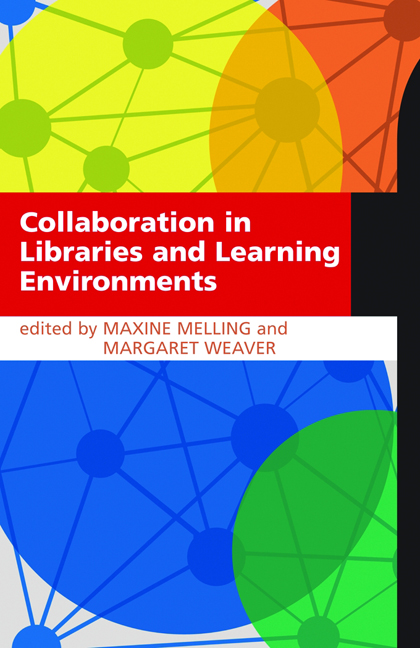Book contents
- Frontmatter
- Contents
- Contributors
- Introduction
- Abbreviations
- 1 The changing higher education context
- 2 Connecting with the student perspective
- 3 Working with professional associations
- 4 Culture, values and change: observations from three consortia in Canada
- 5 Managing complex change collaboratively
- 6 Leadership skills for collaboration: future needs and challenges
- 7 Knowing me … knowing you: the role of technology in enabling collaboration
- 8 Space: changing the boundaries
- 9 Collaborative service provision through super-convergence
- 10 Joint-use libraries and transformational change
- Index
10 - Joint-use libraries and transformational change
Published online by Cambridge University Press: 08 June 2018
- Frontmatter
- Contents
- Contributors
- Introduction
- Abbreviations
- 1 The changing higher education context
- 2 Connecting with the student perspective
- 3 Working with professional associations
- 4 Culture, values and change: observations from three consortia in Canada
- 5 Managing complex change collaboratively
- 6 Leadership skills for collaboration: future needs and challenges
- 7 Knowing me … knowing you: the role of technology in enabling collaboration
- 8 Space: changing the boundaries
- 9 Collaborative service provision through super-convergence
- 10 Joint-use libraries and transformational change
- Index
Summary
Introduction
Joint-use libraries are created between public (also known as community) libraries and university libraries; between public schools and public libraries; between community colleges and universities; and between any library organizations wishing to collaborate on the delivery of library services. These collaborations exist as a result of institutions of higher education and other entities making the bold decision to work across organizational boundaries for the benefit of their library communities to make best use of limited resources. The joint organizations that are created embrace a broader view of mission and vision than do organizations with a more traditional and sometimes insular view of their reason for being. Joint-use libraries exist with a variety of different models of administration and funding, of varying sizes and in different geographic locations.
In August 2003 the 475,000 square foot (44,000 square meters) Dr Martin Luther King, Jr. Library (King Library), a joint-use library created by San José State University (SJSU) and the City of San José, opened to serve their respective communities. The grand opening was met with applause and rave reviews by the close to 12,000 people who were on hand for the festivities that day. As the tenyear anniversary looms (August 2013), the King Library has provided stellar library services, technological innovation and access to print and digital collections for the fifth largest campus in the California State University (CSU) system, the third largest city in California and the tenth largest city in the USA. A review of the planning process employed to develop this joint library and an exploration of the accompanying staffing issues, user perceptions, budgetary matters and other factors are instructive in understanding the operation of such a library. These observations can provide a foundation for predictions for the next ten years of collaboration in light of exponential technological advances, innovation in higher education and the ‘new normal’ of decreased tax-generated funding for public libraries and state-supported universities in the USA.
- Type
- Chapter
- Information
- Collaboration in Libraries and Learning Environments , pp. 167 - 184Publisher: FacetPrint publication year: 2012
- 1
- Cited by



